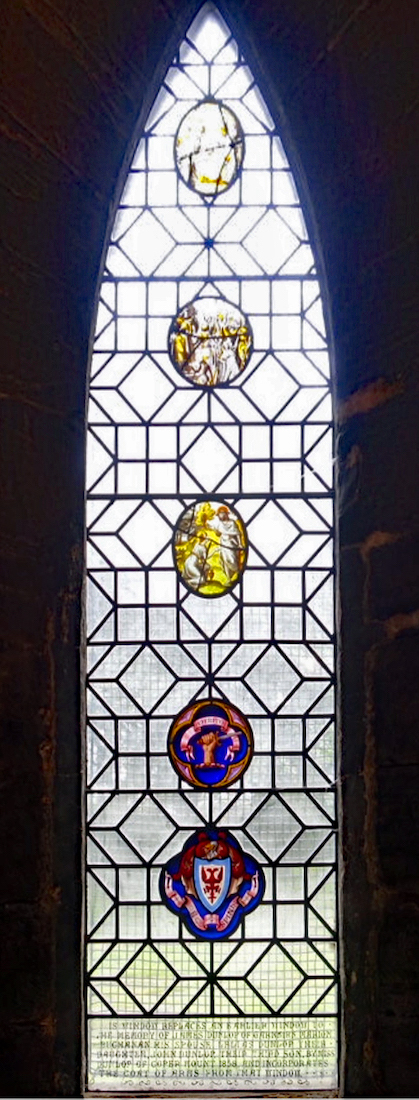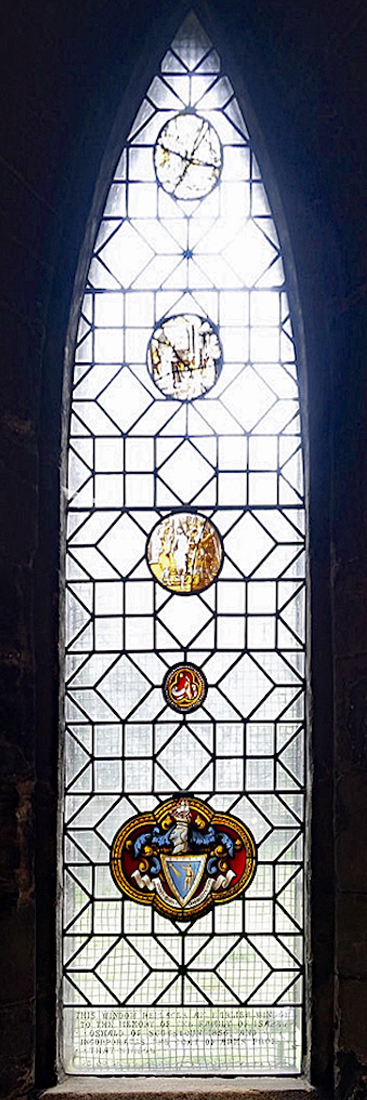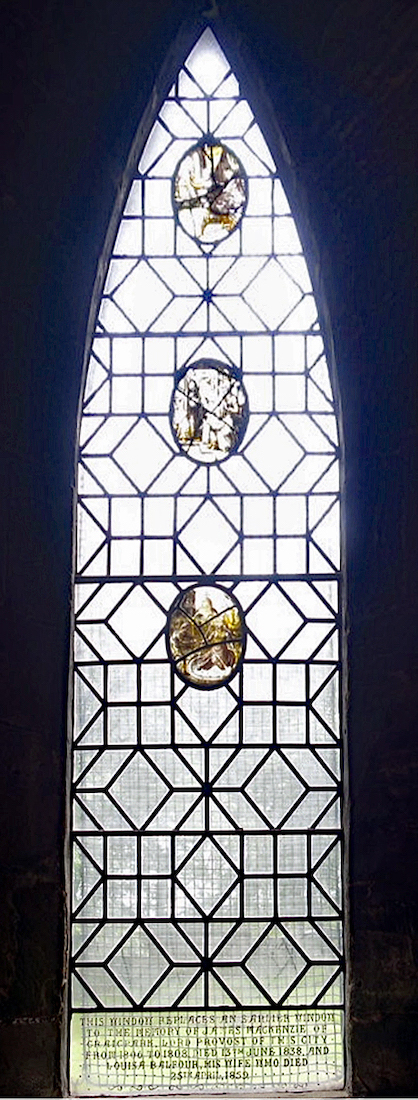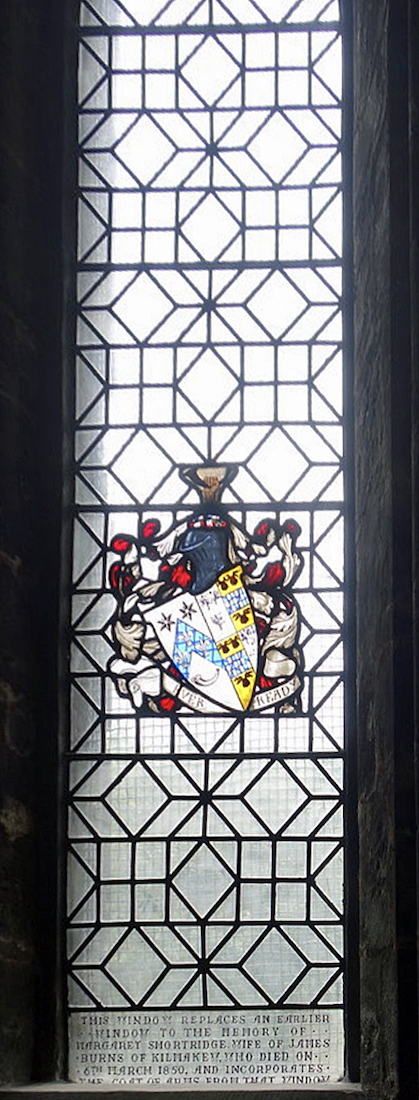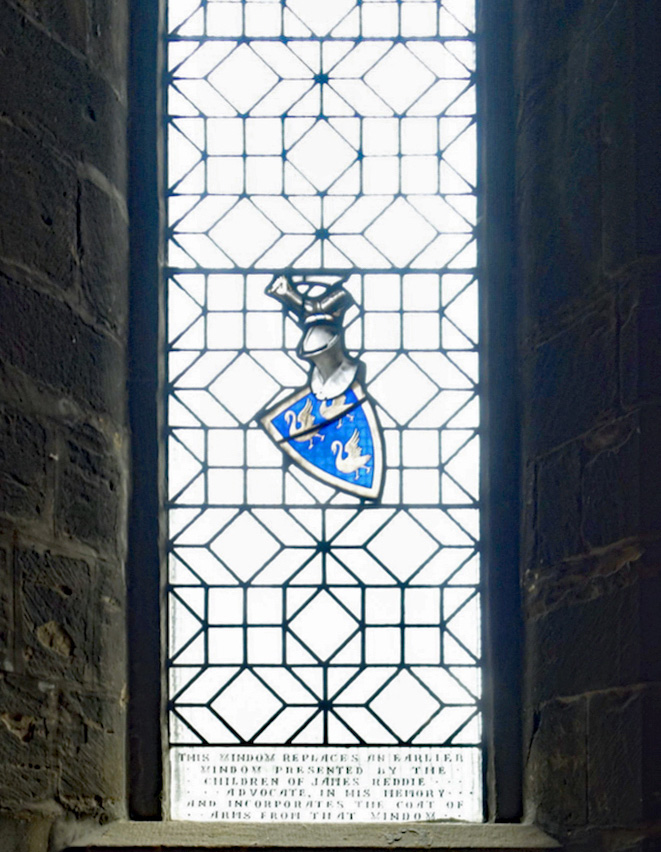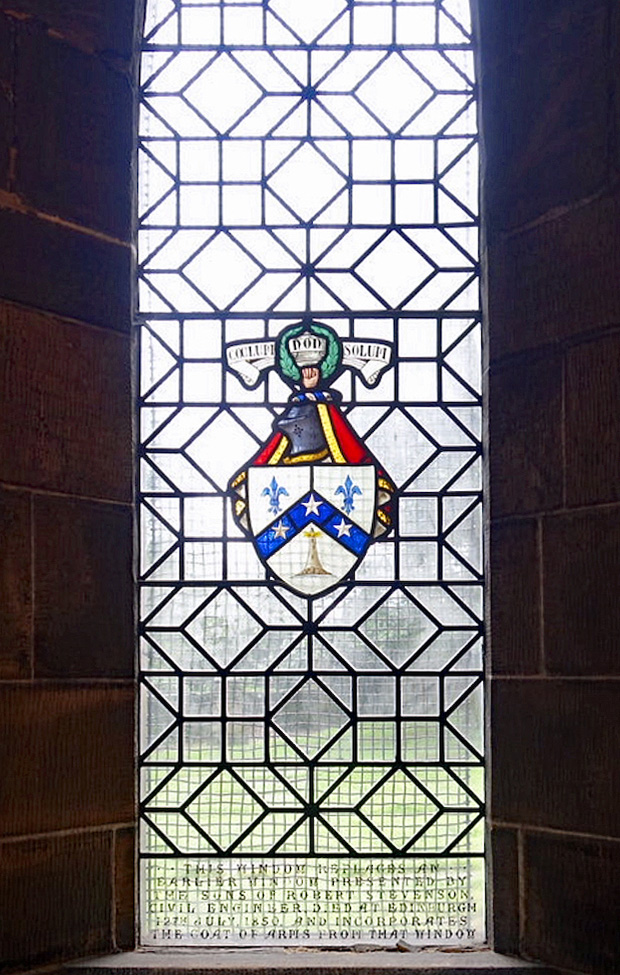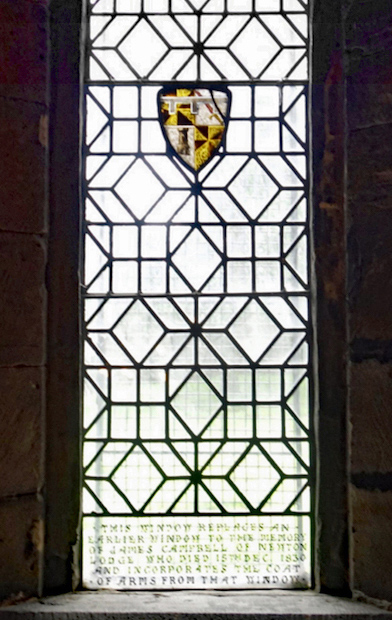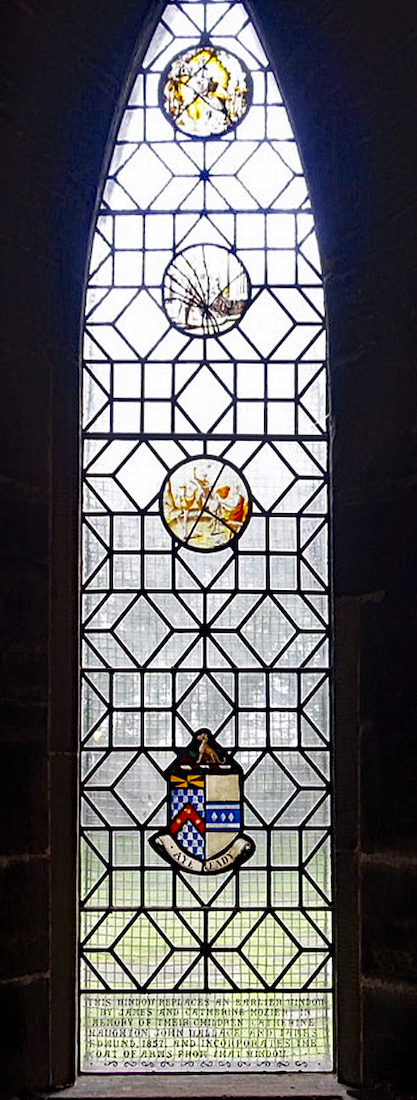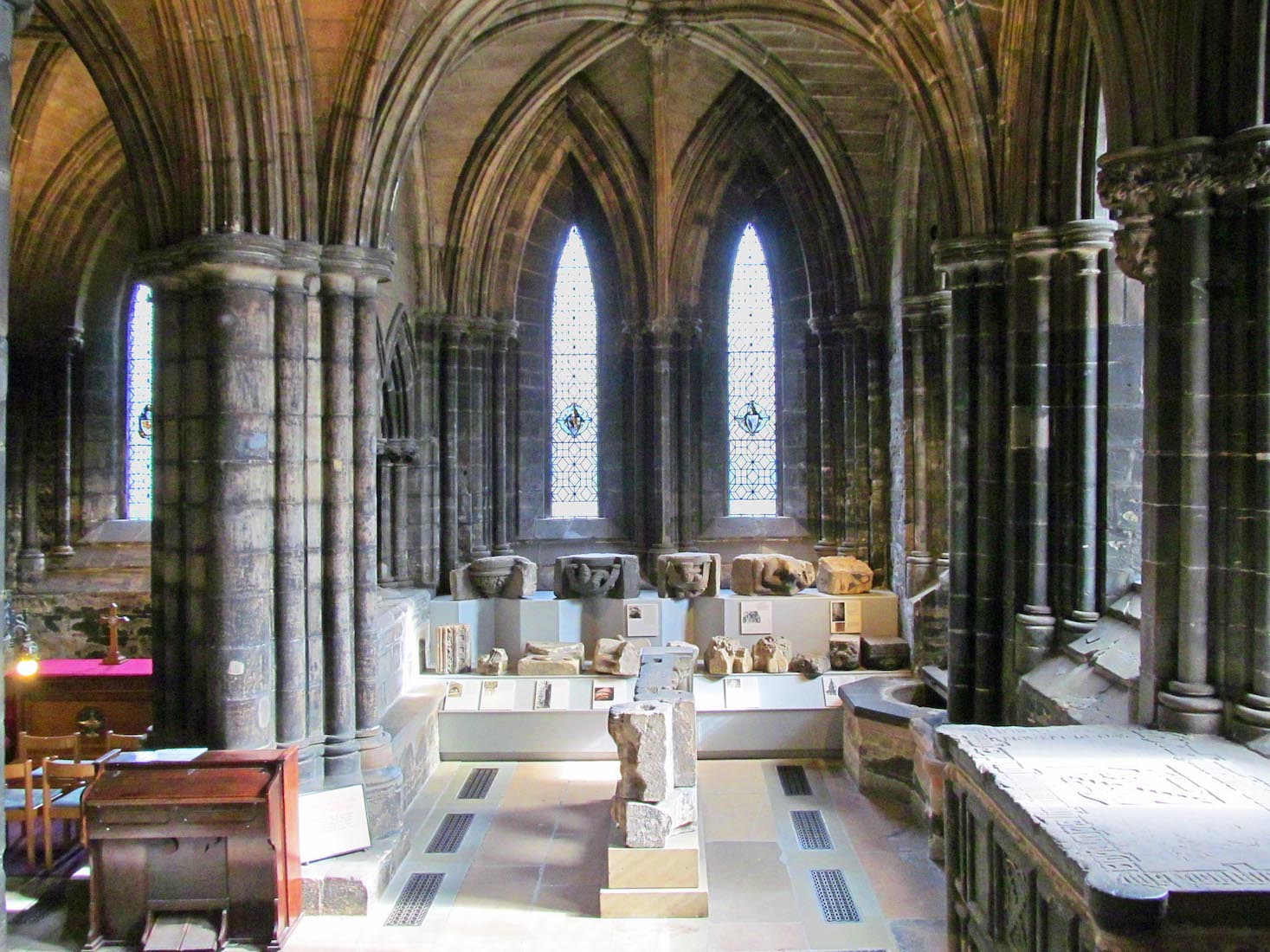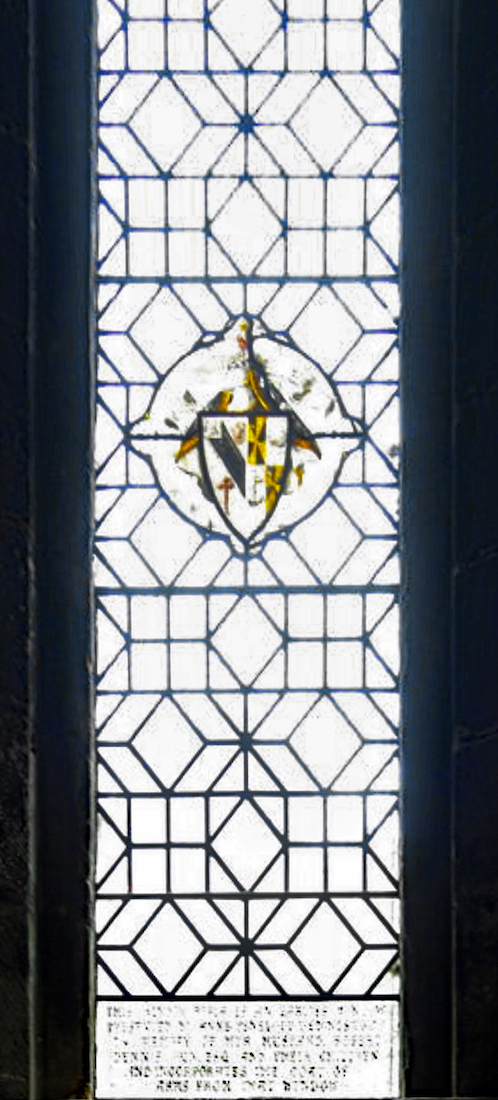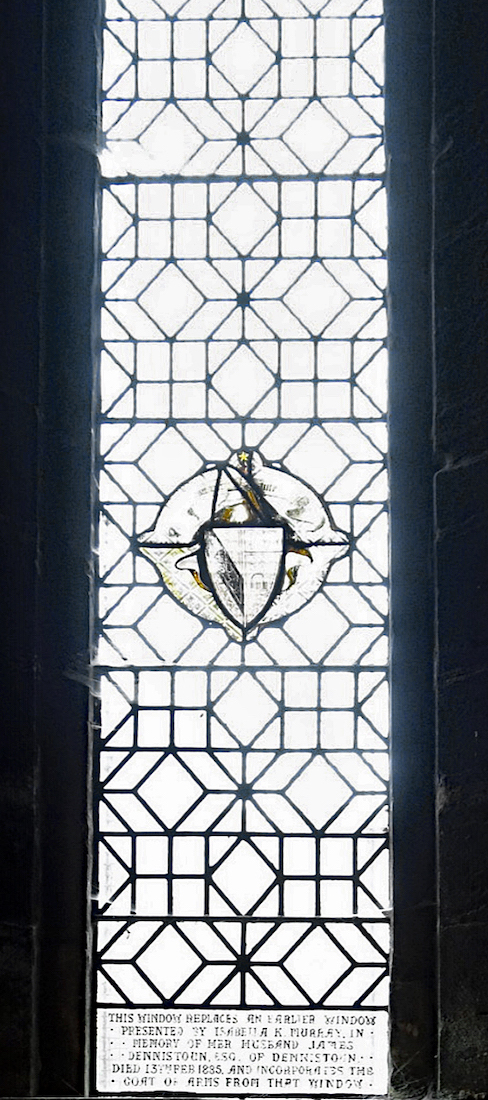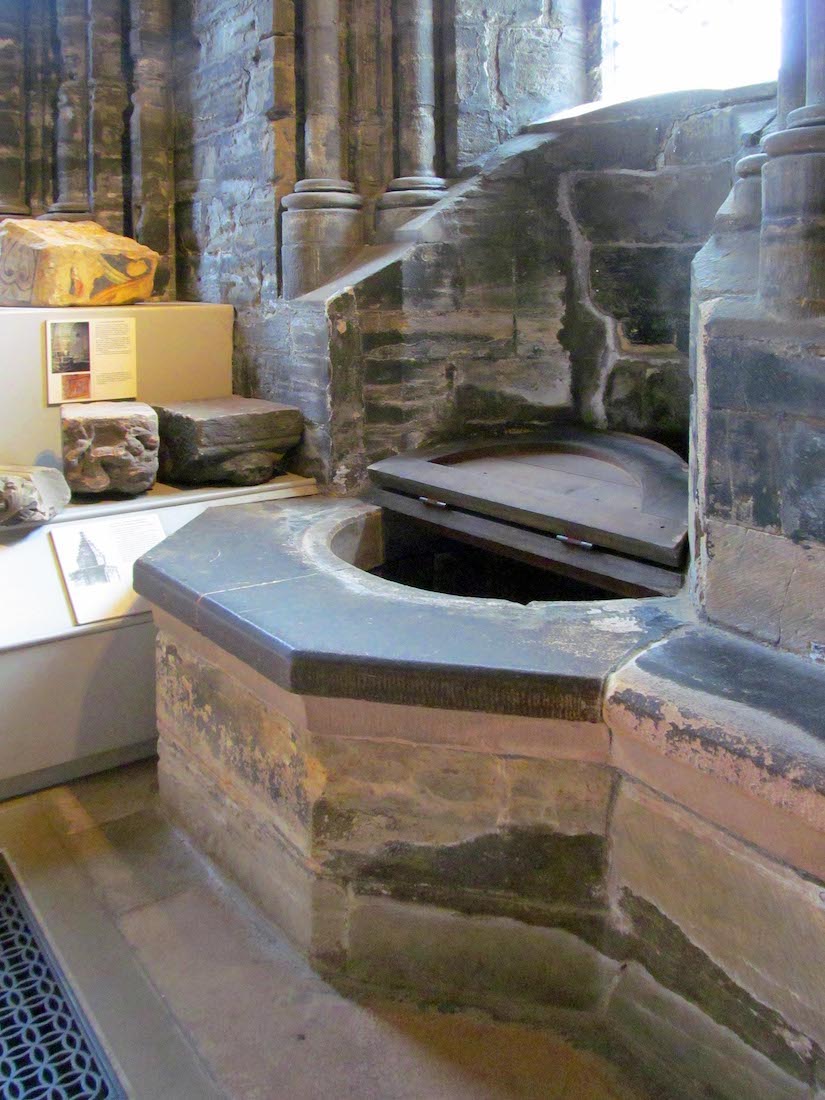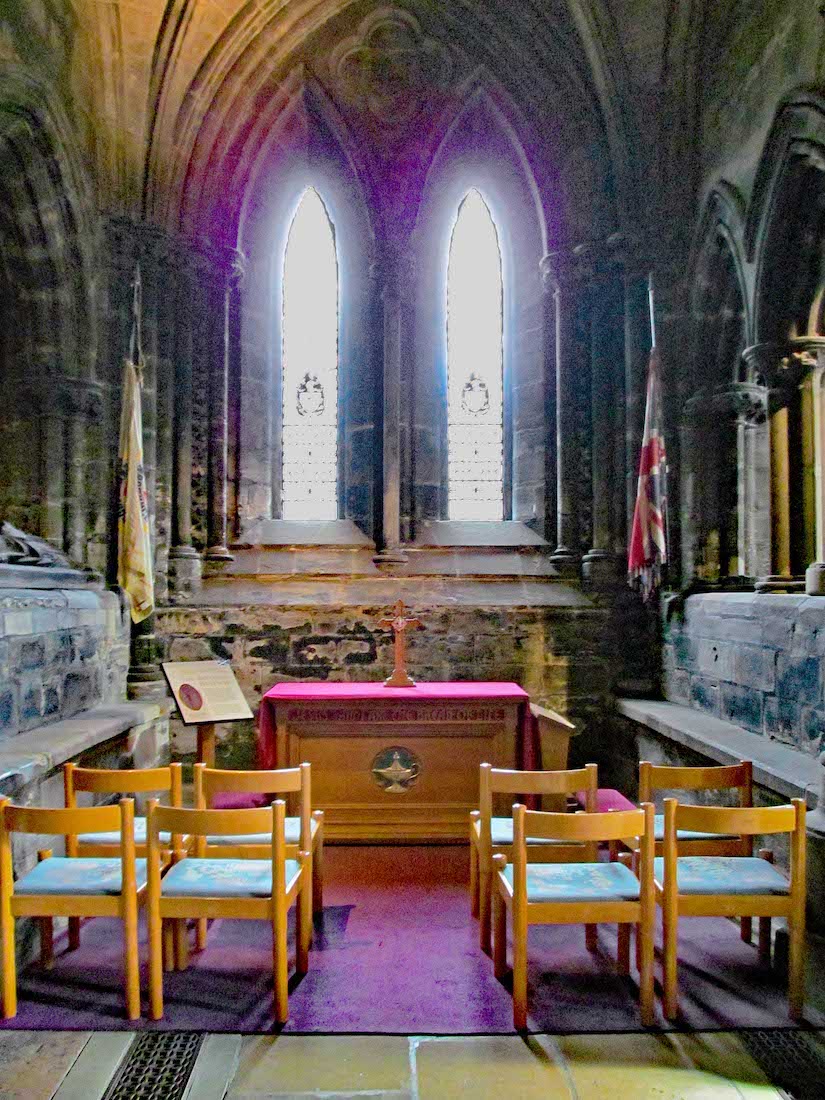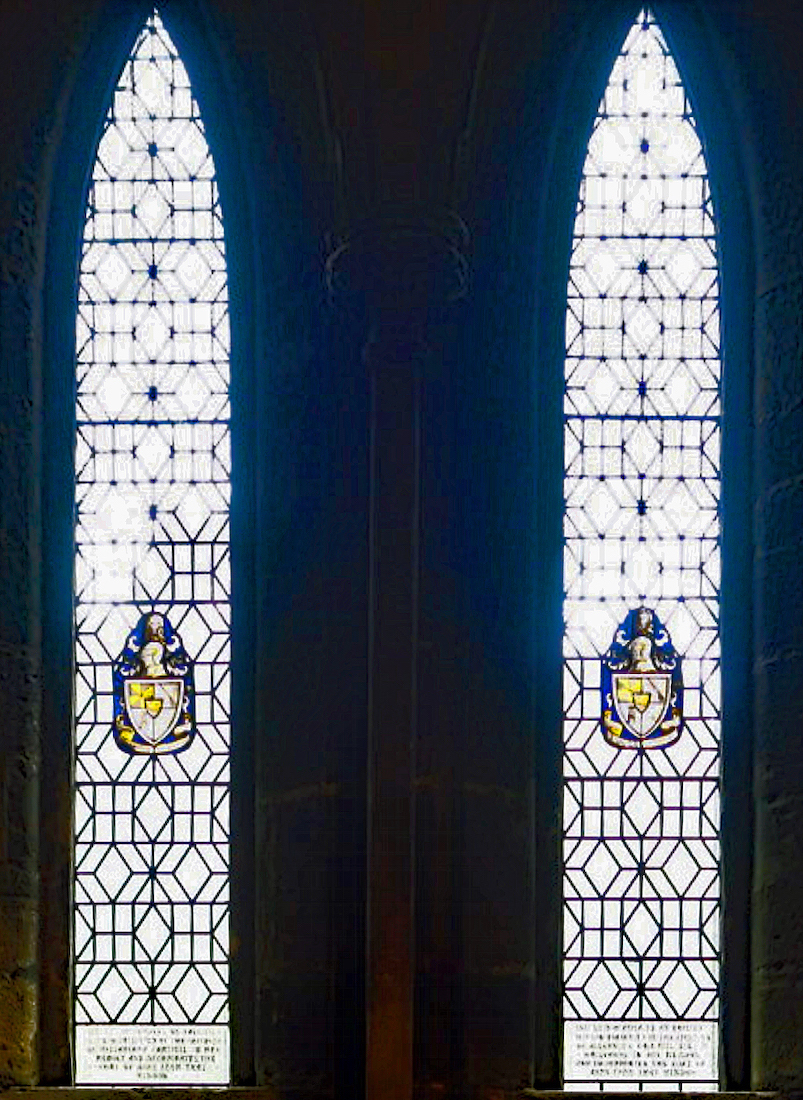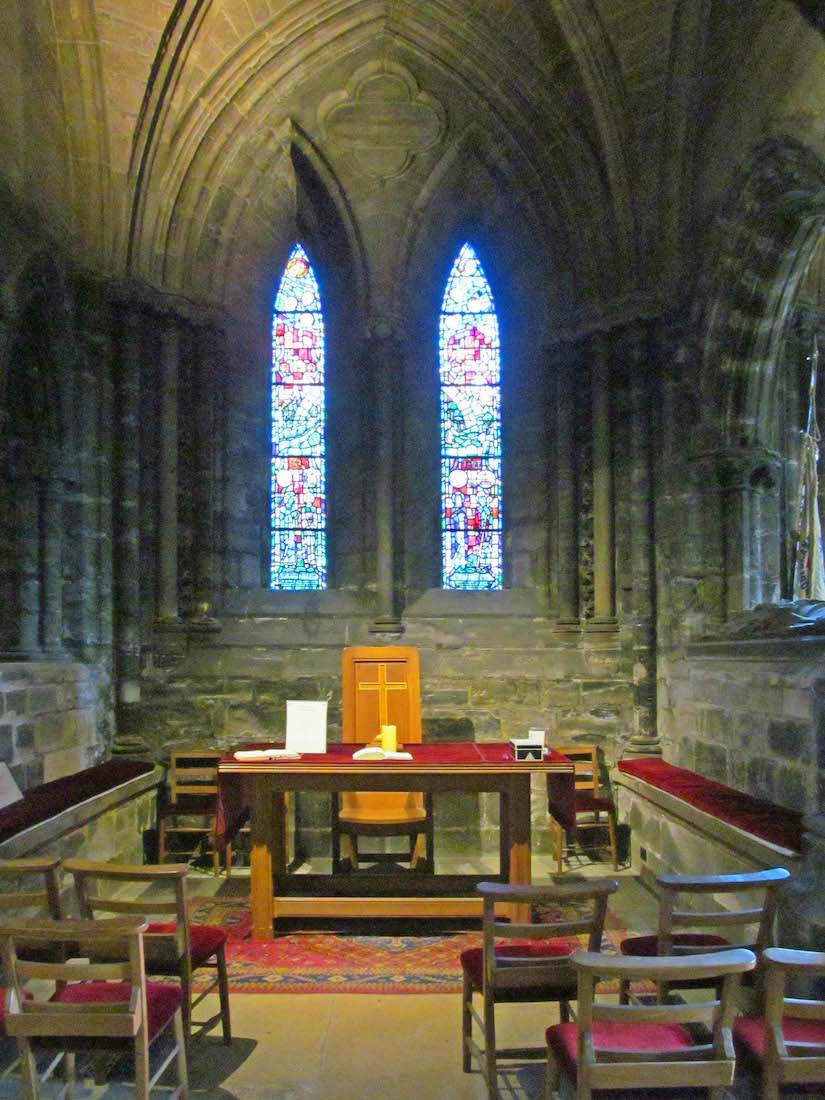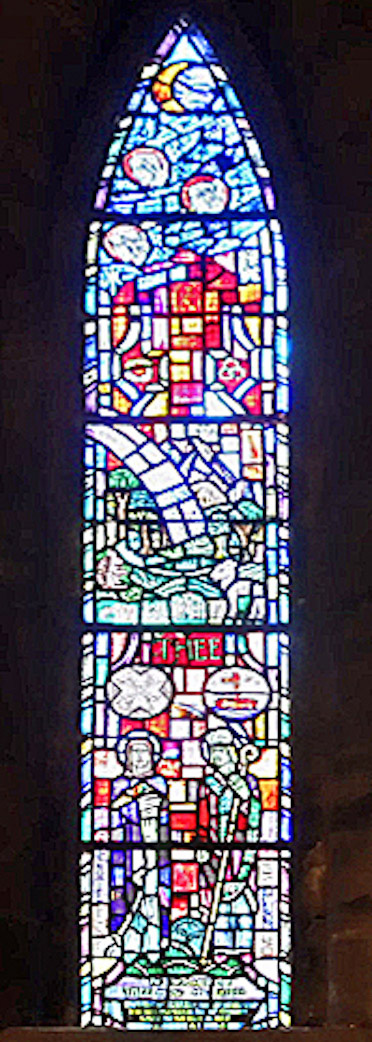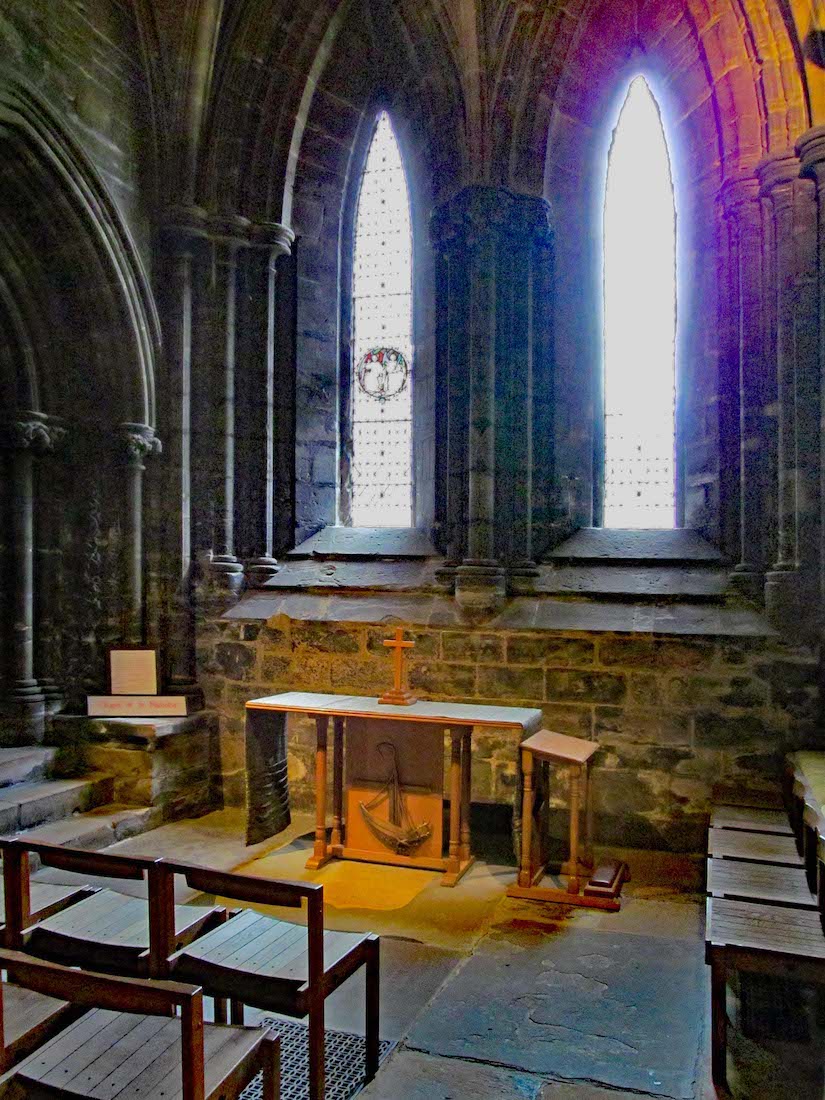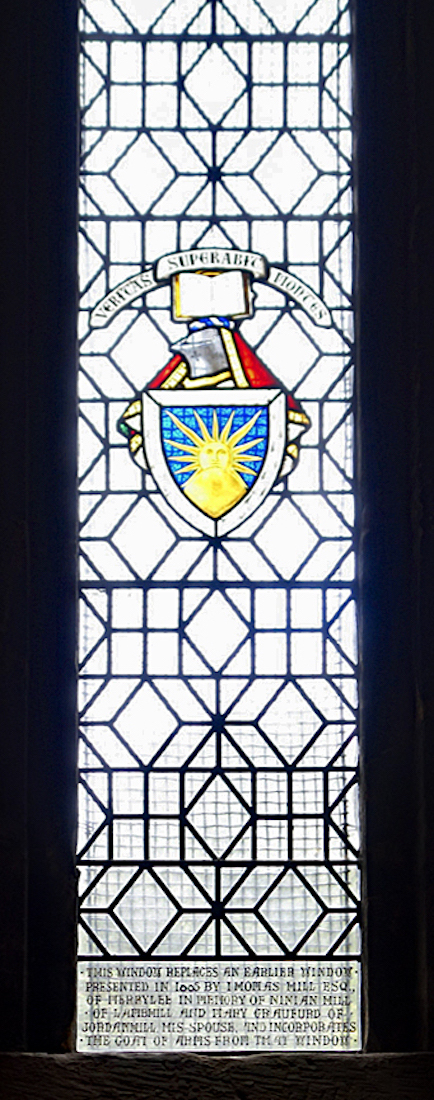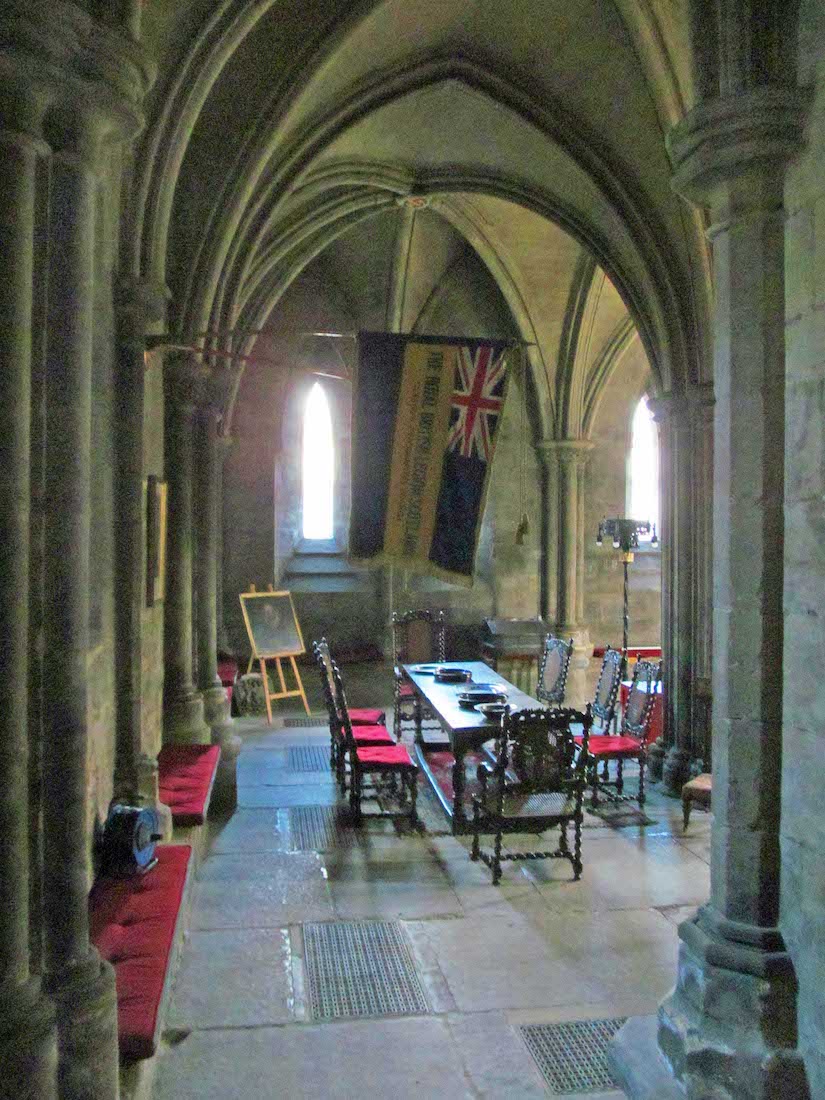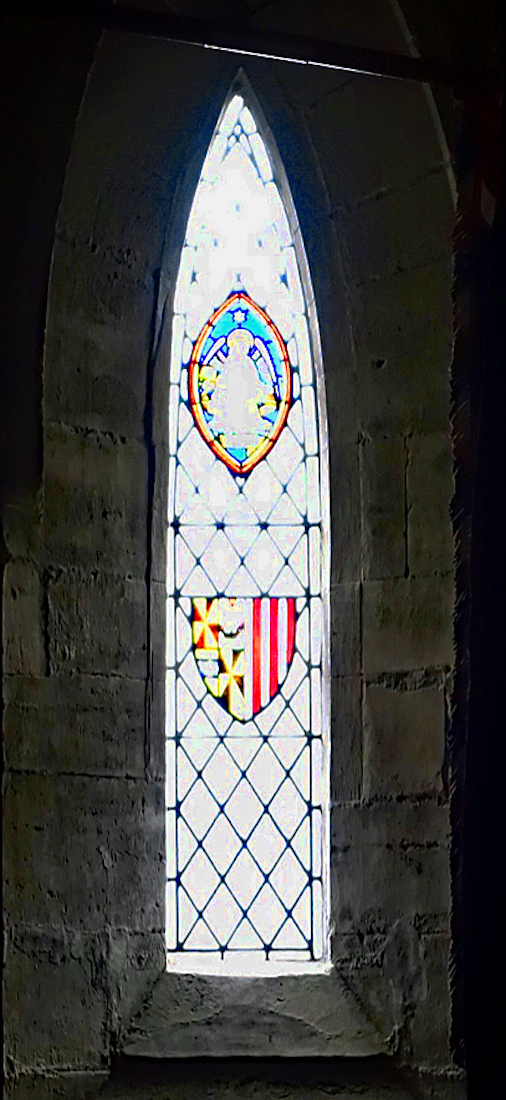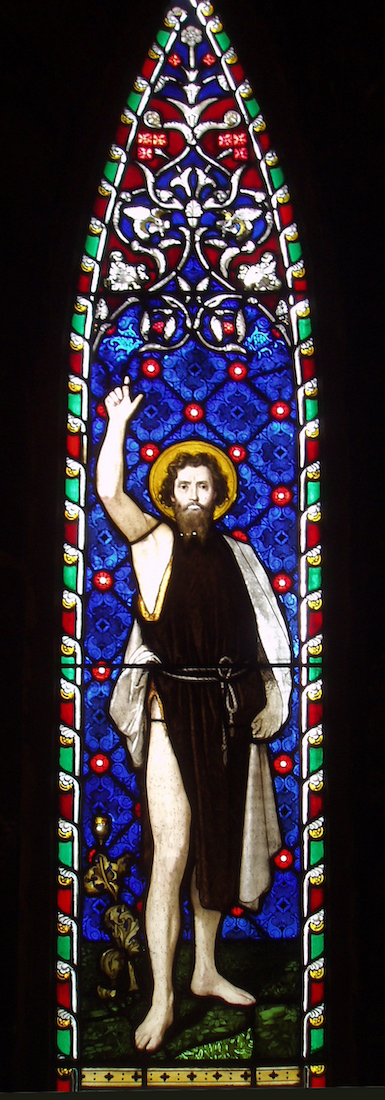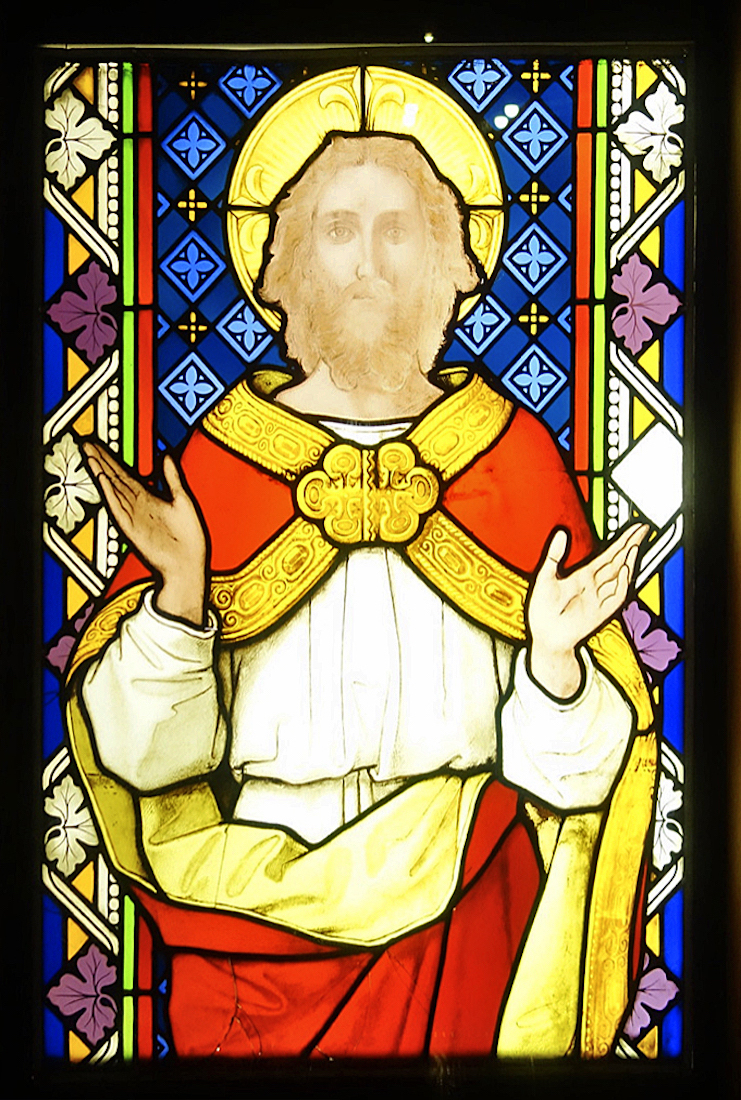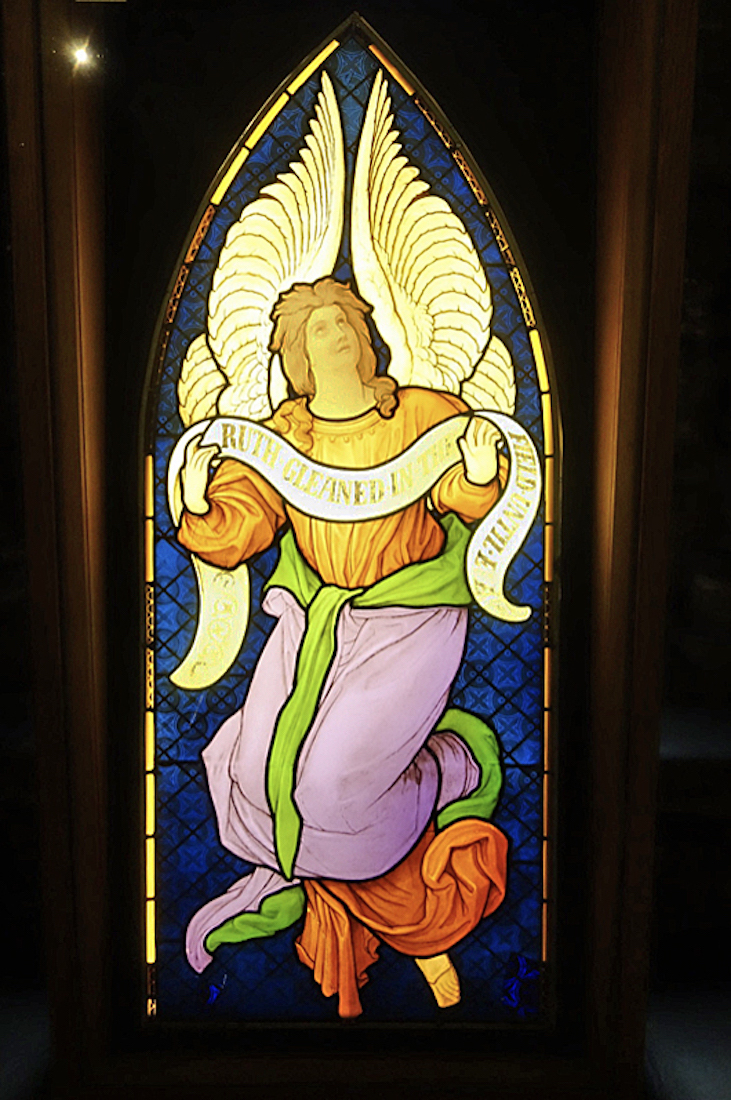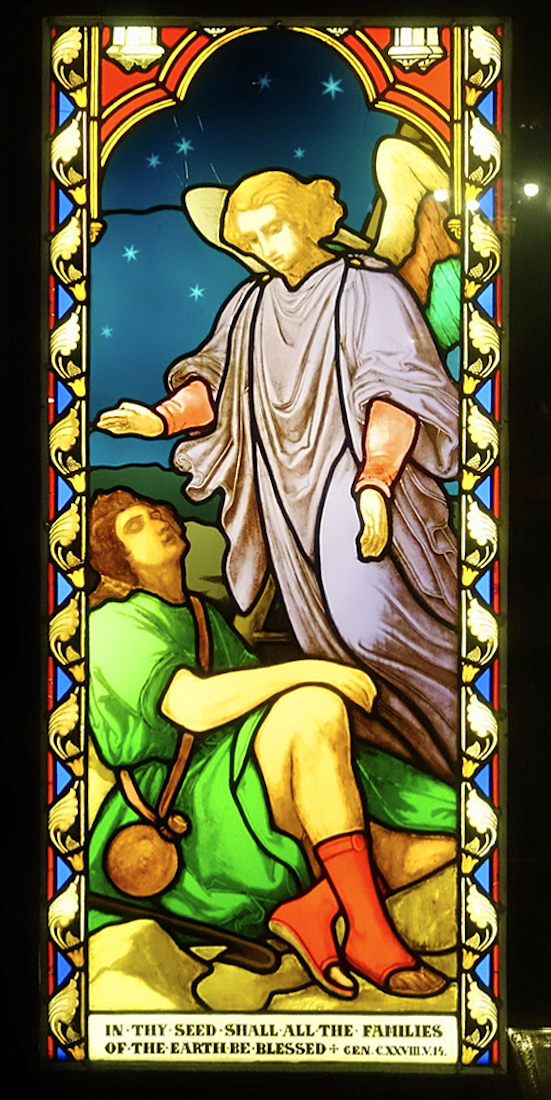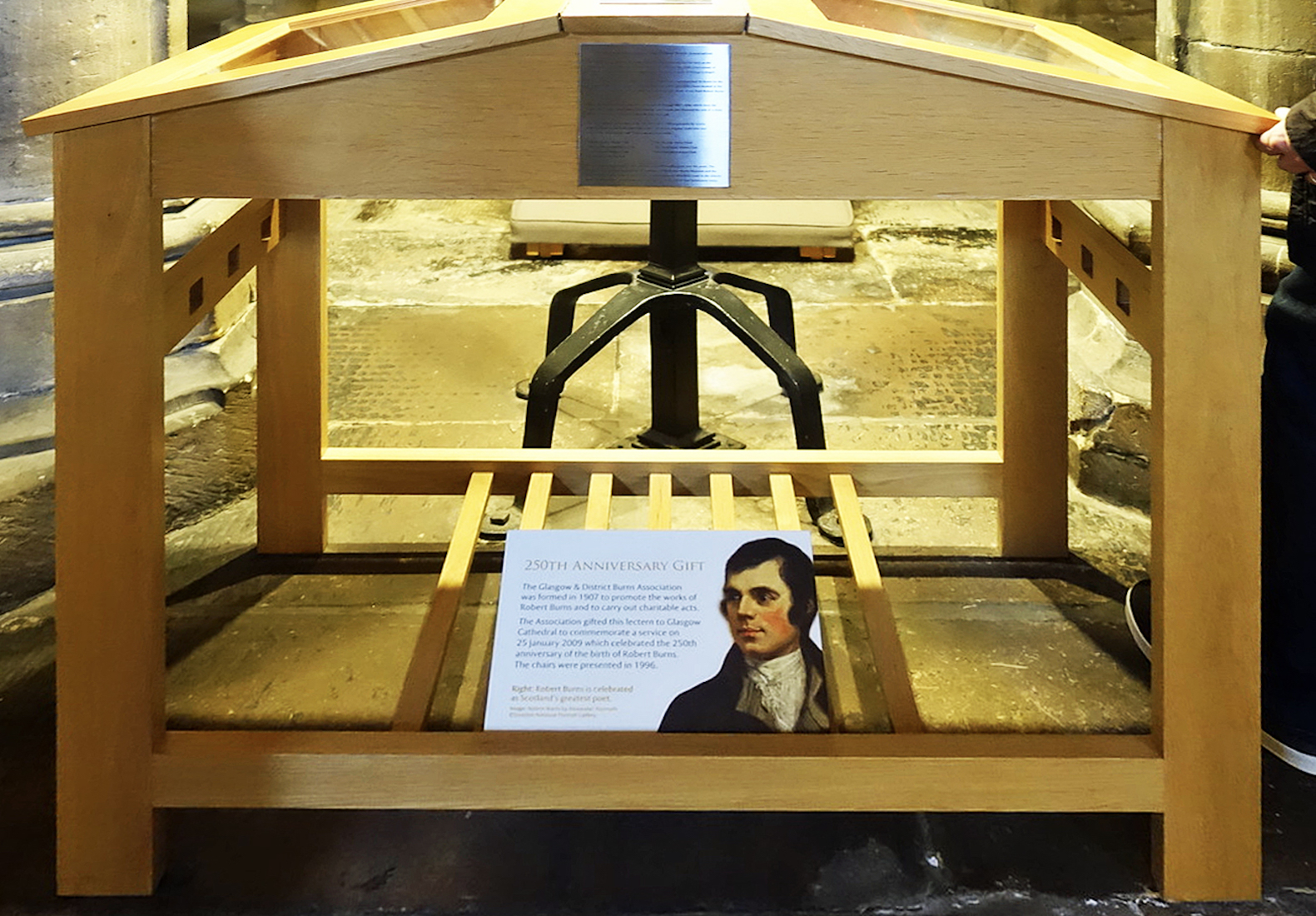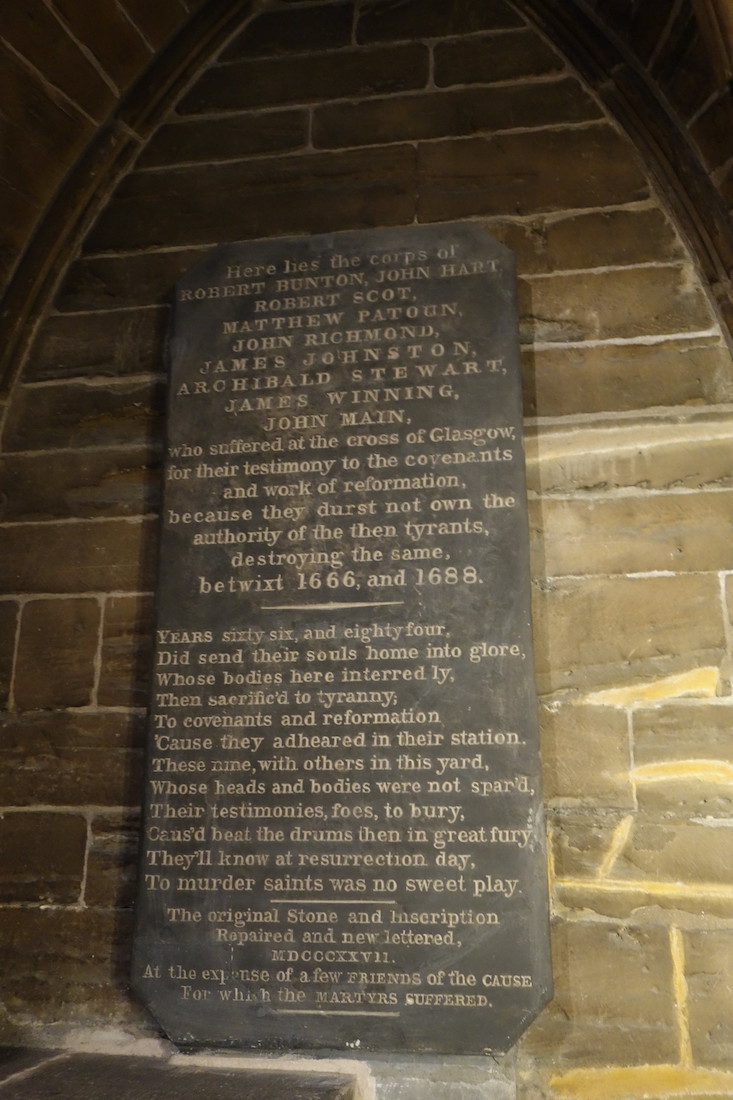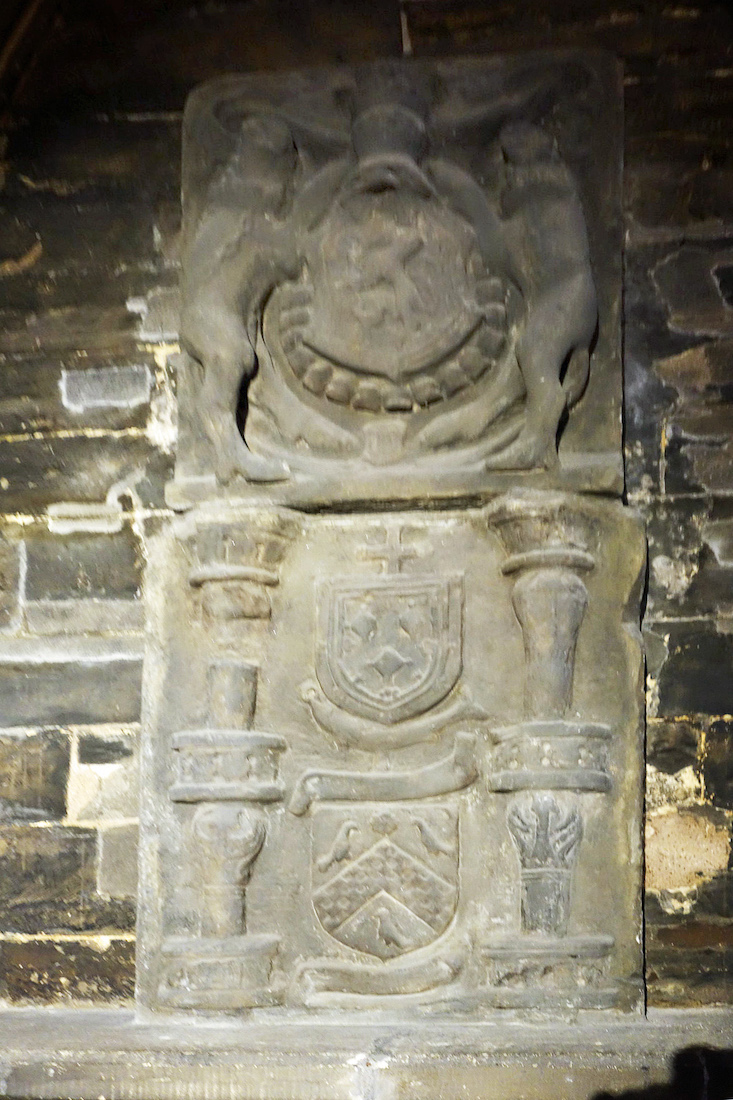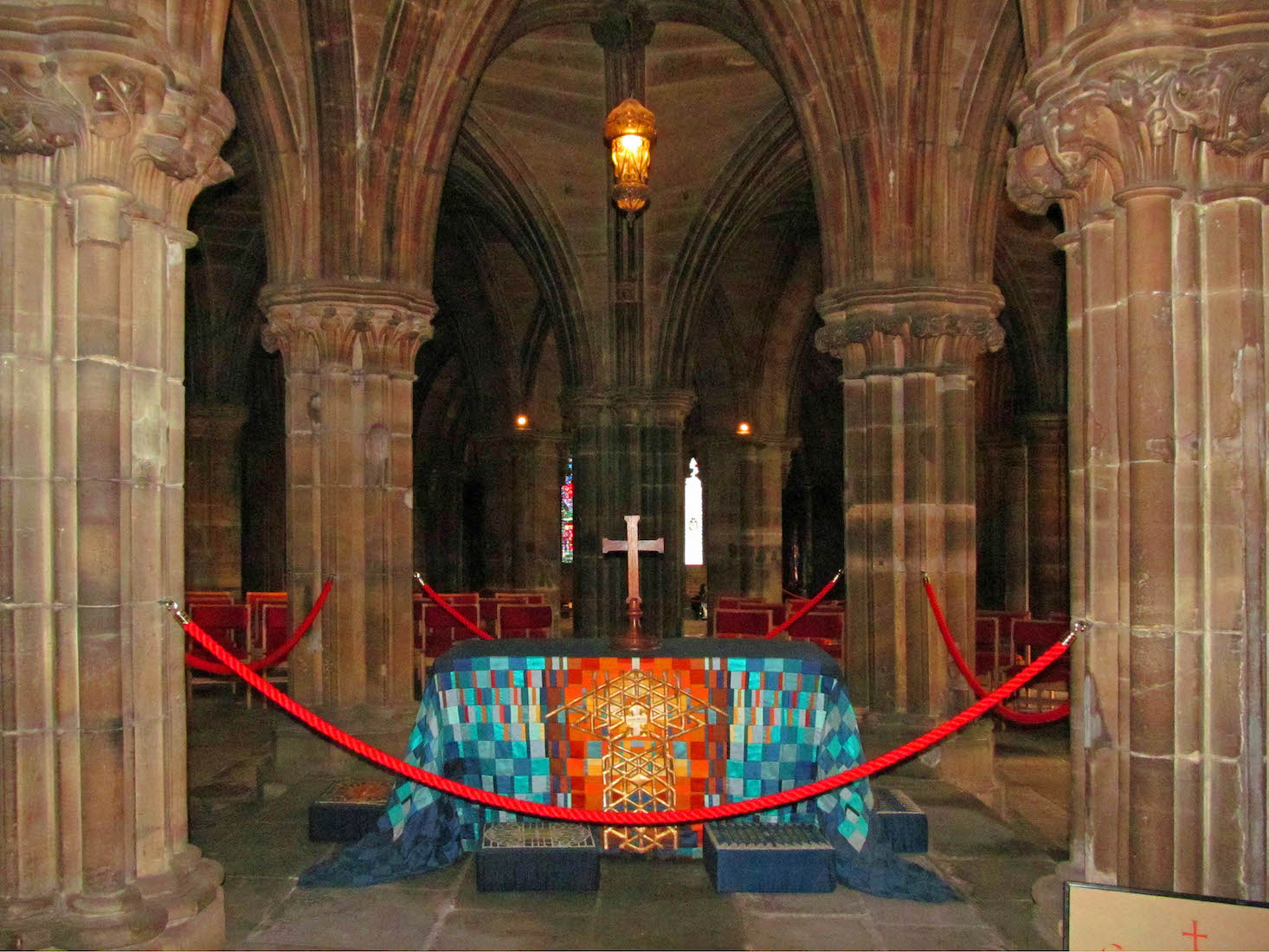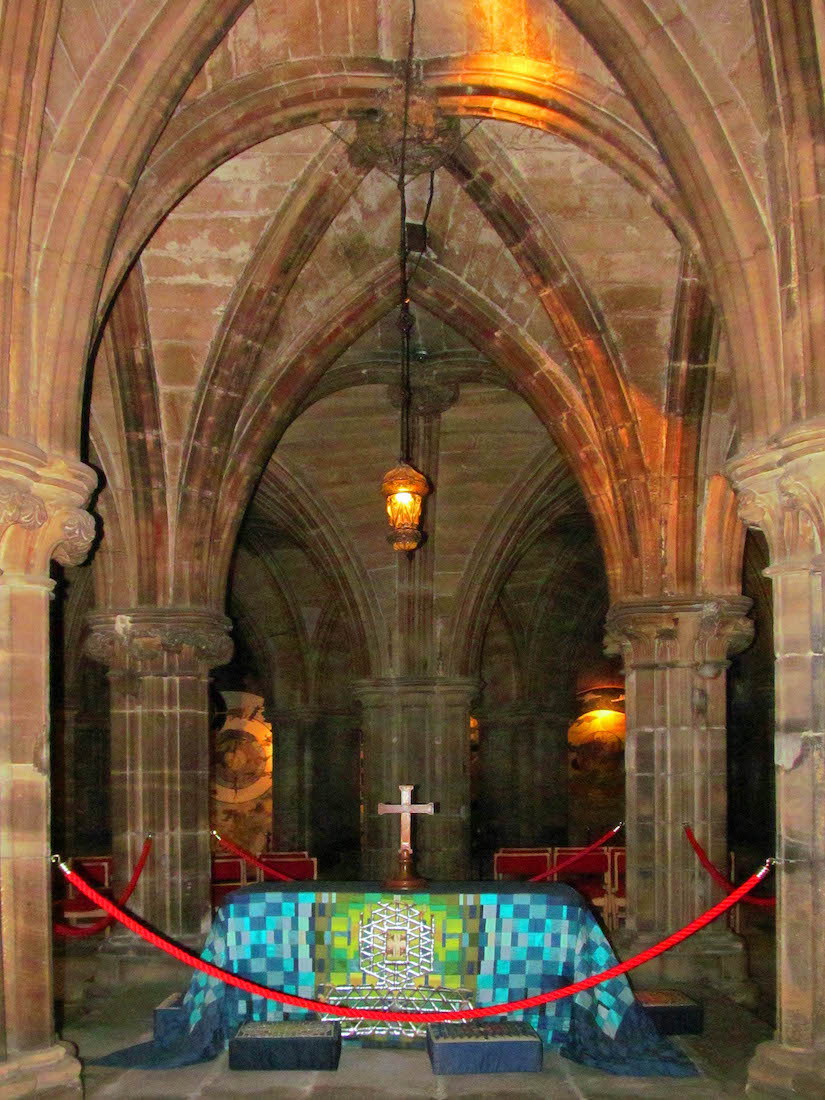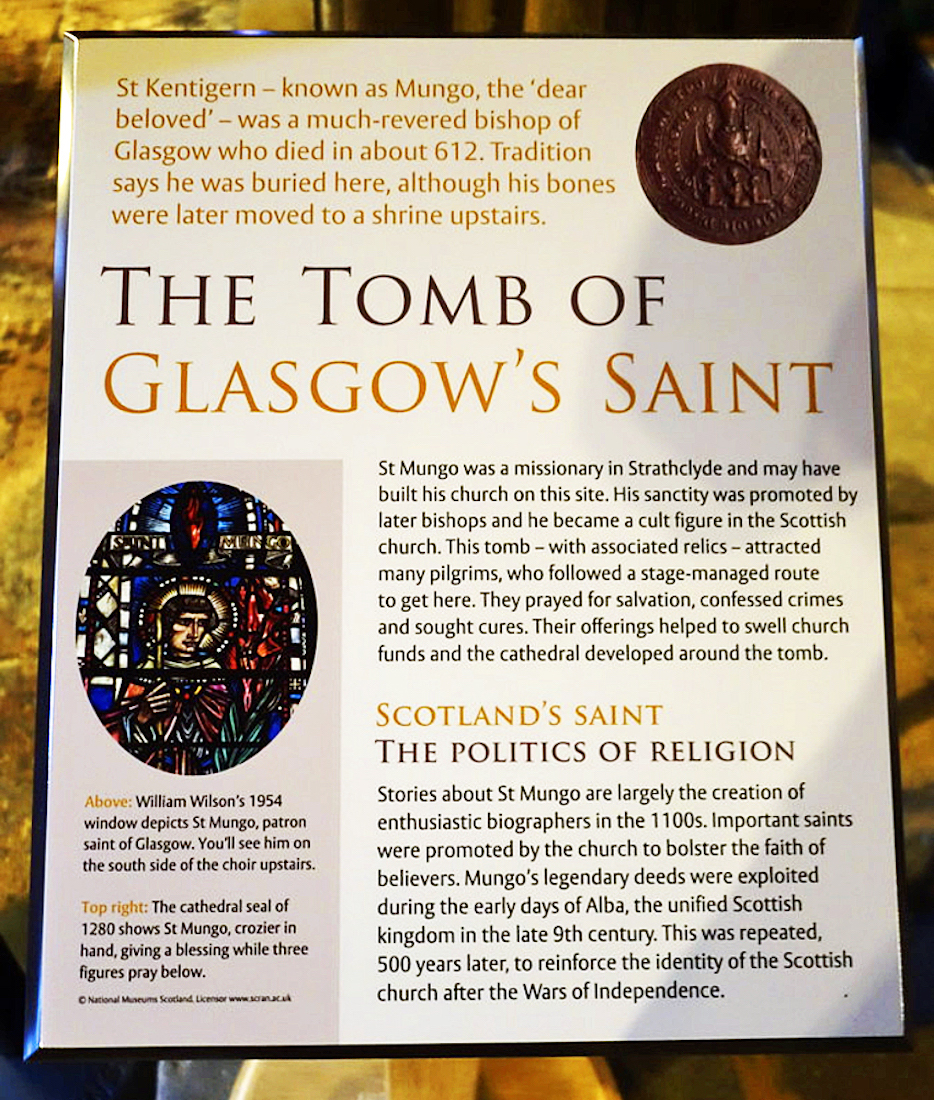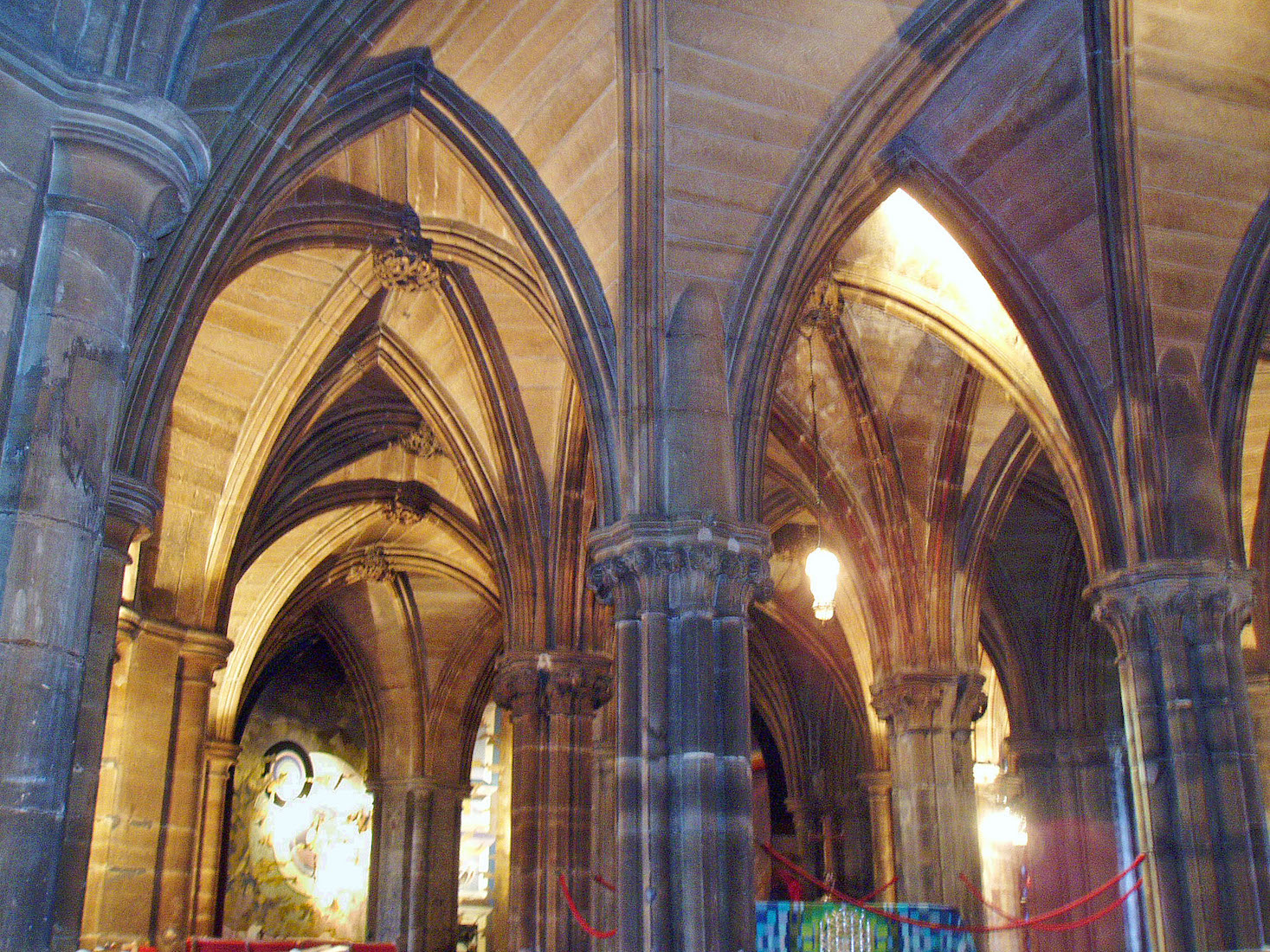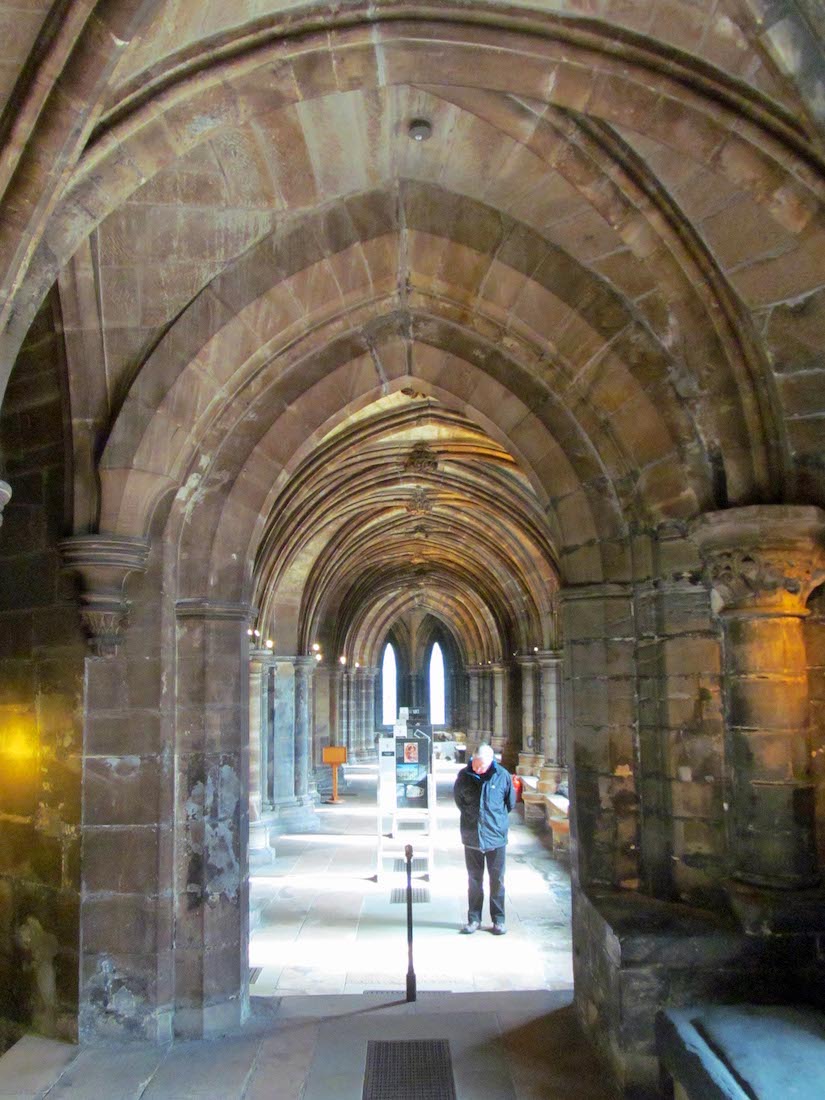
We come up from the Blacader aisle, and stand on the landing, looking East. To our left are steps back up to the nave, and before us are a few steps down to the South aisle of the crypt or lower church. We shall use the word ‘crypt’ because it is short and easy, but this space is neither dark nor damp! Our plan is to explore the crypt, starting with this aisle, and moving in an anticlockwise direction. We shall find many windows, mostly single lancet, to our right, letting light onto the aisle. There are also a number of poster boards giving information about the Cathedral and its history. INDEX
C2. SWORD AND WINDOW IS IS
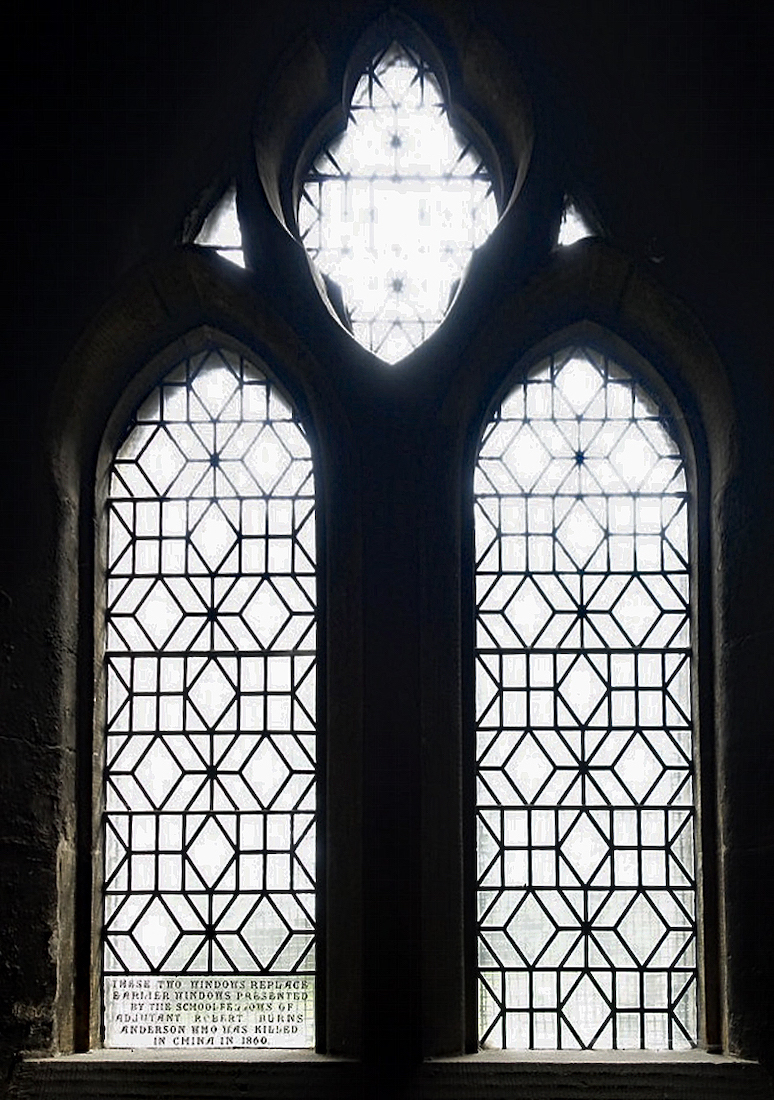
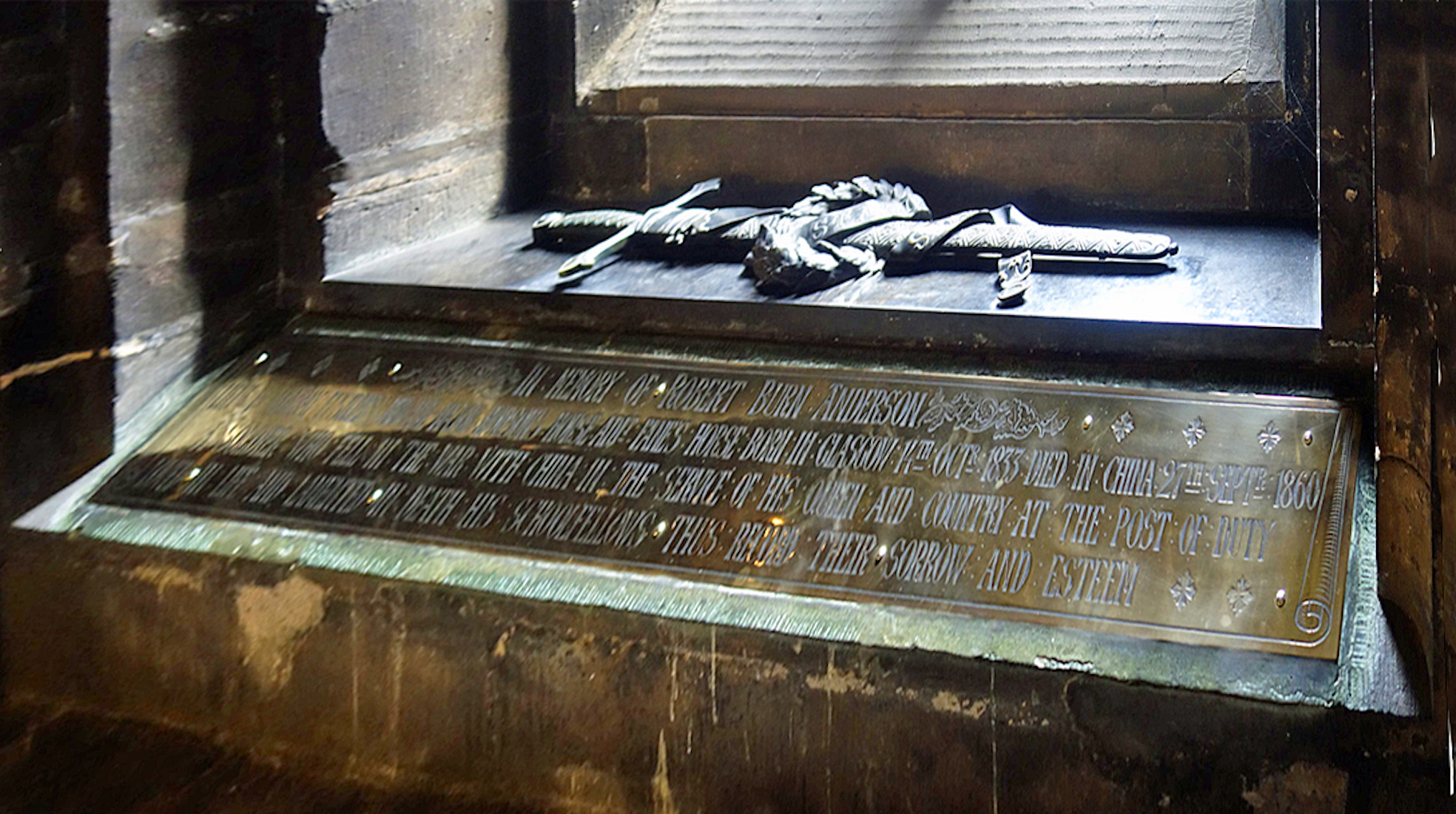
The first window on our right has clear glass held by interesting geometric leading. A small pane at bottom left has the text: These two windows replace earlier windows presented by the school fellows of Adjutant Robert Burns Anderson who was killed in China in 1860. On the sill is a memorial to Anderson by sculptor R. Jackson of London.
C3. FOUR WINDOWS IS IS IS IS
The next four single lancet windows have inserts of various roundels and crests. From the texts at the base of the windows we find that the windows, from left, are in memory of: • Innes Dunlop; • Oswald of Scotstoun; • James MacKenzie of Craigpark, Lord Provost of this City from 1806 to 1808. Died 1838. And Louise Balfour, his wife, who died 1859 • Margaret Shortridge, wife of James Burns of Kilmakew who died in 1850 and incorporates the arms from that window.
C4. FOUR MORE WINDOWS IS IS IS IS
Some details of the next four windows along the South aisle, as given by the texts at the base are, from left, : • James Heddie, Advocate; • Robert Stevenson, Engineer, died in Edinburgh 1850. Notice the emblem of the lighthouse. • James Campbell of Newton Lodge who died in 1830; • Children of James and Catherine Mozier.
C5. CHAPEL OF ST JOHN THE EVANGELIST WH
At the Eastern end of this aisle, and in fact right across the crypt, several steps descend to the Eastern ambulatory and four adjacent chapels. The right (Southern-most) chapel is the Chapel of St John the Evangelist (Geologist?!) The chapel contains fragments of the Shrine of St Kentigern, dating from the thirteenth century, and other fragments including some from the Western towers.
C6. CHAPEL WINDOWS IS IS
This Chapel has two facing windows in the East wall, and a more colourful window to the South. Like the previous windows, these windows are all replacements. Information from the window tests shows that these windows were given in memory of, from left: • ? • James Dennistoun from Dennistoun, who died in 1885; • John Hamilton Gray of Carntyne and Caroline his wife, 1869. This last window by Clayton and Bell shows St Kentigern baptising the child of Rhydderch, King of Strathclyde.
C7. ST MUNGO’S WELL WH
This well is situated in the Southeastern corner of the chapel of St John the Evangelist. The origins of the Cathedral date back to 500AD when St Mungo (aka St Kentigern) founded a small church on the site of the current Cathedral. The well possibly dates from that time with its water being used for services in the Cathedral, and thought to be therapeutic.
C8. NURSES’ CHAPEL WH IS
The second chapel is the Chapel of Saint Andrew, dedicated to the nurses of Scotland. The Chapel was refurnished and brought back into use, after an interval of 400 years, on Whit Sunday 1961, as a place of prayer and meditation for members of the nursing profession. Malcolm Lochhead was commissioned by the Nursing Organisations of Scotland to design eight embroidered chairs to become the focal point of its furnishing. The two windows are obviously memorial windows.
C9. THE CHAPEL OF ST PETER & ST PAUL WH IS IS
Moving along the Eastern ambulatory, we next come to the Chapel of St Peter and St Paul. This is another simple chapel with a facing altar (communion table) and chairs grouped around. At right the (headless) effigy of Robert Wishart (1271 – 1316) lies under the dividing arch. The window is by Gordon Webster and commemorates the Very Revd Dr Nevile Davidson (1935–1967), and was unveiled in 1979. The window has a theme of praise, and depicts St Peter and St Paul.
C10. ST NICHOLAS’ CHAPEL WH IS IS
The Northern-most chapel, formerly dedicated to St Nicholas, was furnished and rededicated for the worship of the Cathedral Sunday School in 1969, in the presence of the Queen and Prince Philip. The communion table has the symbols of St Nicholas, patron saint of seafarers and children. At left we can just see the doorway which leads through to the Lower Chapter House. • Most of the Munich and other Victorian windows in the Lower Church were removed, and replaced, as here, by clear lattice windows with an inserted crest or roundel.
C11. LOWER CHAPTER HOUSE WH IS
Coming to the Lower Chapter House we find a grill blocking public access! We can still get this partial view. The Cathedral Guidebook tells us that this was a 13th century chamber, reconstructed in the 15th century. It is arranged as a chapter house with seating around the walls, and a canopy in the East wall. There were twelve windows given by James Spens Black in 1863, depicting angels, emblems of Christ, and the Four Evangelists. Today each window bears only the arms of the donor’s family, along with a mandorla panel bearing emblems of our Lord and of the Four Evangelists.
C12. TWO WINDOWS IS IS


As we face the chapter house, there are two attractive matching single lancet windows on our left. Each has an anchor at the top, an array of shields at the bottom, and a scene between. In the lancet at left St Mungo & St Columba present the Cathedral to King Rhydderch. This window by Ballantine and Allan was installed in St Mungo’s Cathedral in 1857. It depicts the two major saints of the city presenting the cathedral to the Anglo-Saxon king of Strathclyde. The lancet at right depicts three post-Reformation archbishops: James Boyd, Alexander Burnett and John Patterson. The model of the Cathedral has been cast down to the ground, probably symbolising the ending of episcopacy in the Church of Scotland.
C13. ST JOHN THE BAPTIST WINDOW AMT
We climb the few steps up from the East ambulatory, back to the North aisle of the crypt. Along this aisle we come to John the Baptist looking in. This window by Pompeo Bertini of Milan (1867) was given in memory of Rev Edward Irving, founder of the Catholic Apostolic Church. It is Irving’s face in the window!
C14. MUNICH WINDOWS IS IS IS
A little further along this aisle, standing up in a vertical position, is this set of Munich windows. Pictured here from left are: • Figure of Christ; • An angel with a text about Ruth; and • Jacob’s Dream. In the mid-19th century the Cathedral commissioned The Royal Bavarian Stained Glass Est. near Munich to create a set of stained glass windows for the Cathedral, and these were installed 1859–1864. Unfortunately the windows deteriorated badly and were almost all removed and replaced by 1960. The rose window above the South door is the only remaining complete window. The rest are in storage, and here we see three examples.
C15. ROBBIE BURNS’ LECTERN IS
Our next find is this lectern which was gifted to the Cathedral in 1996 by the Glasgow & District Burns Association. The occasion was 25 January 2009 which celebrated the 250th anniversary of the birth of Robert Burns.
C16. GENERAL VIEW AMT
It is worth taking time to appreciate the architecture of the crypt, which is said to be one of the finest in Europe.
C17. MEMORIAL AND STONES IS IS
There are two more items of interest along the North aisle. The tablet shown at left contains the names of nine Covenanters – Scottish martyrs who were executed in Glasgow in 1666 – 1688 for their efforts to reform the Church. At right are shown some stones from the former Bishops Palace which was located near the Cathedral.
C18. ST MUNGO’S TOMB WH
The main feature of the central crypt is the tomb of St Mungo. The site is now covered by a table with a modern embroidered cloth. The front of the cloth represents the warmth of the Church with an image of a tree (Mungo) a burning bush (Church of Scotland) and the cranes of the ship yards which made Glasgow great.
C19. ANOTHER VIEW WH IS
The cloth on the table over St Mungo’s tomb looks different when viewed from the East. This east face represents the river Clyde with a silver bell and a fish representing Saint Mungo. Fifty-four members of the Glasgow and West of Scotland Embroiderers’ Guild created the embroidery. From here we can see a large tapestry which covers the far wall of the crypt.
C20. CRYPT ARCHES AMT
We leave St Mungo’s tomb, and make our way through the forest of columns to inspect the tapestry.


